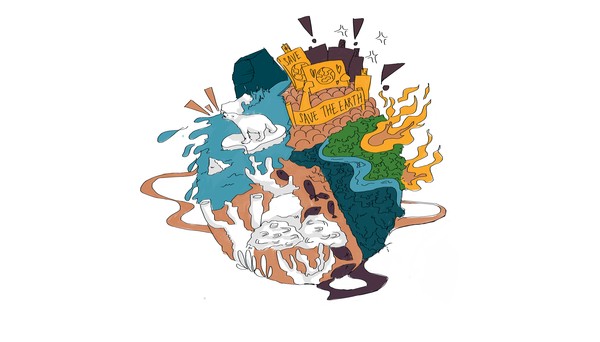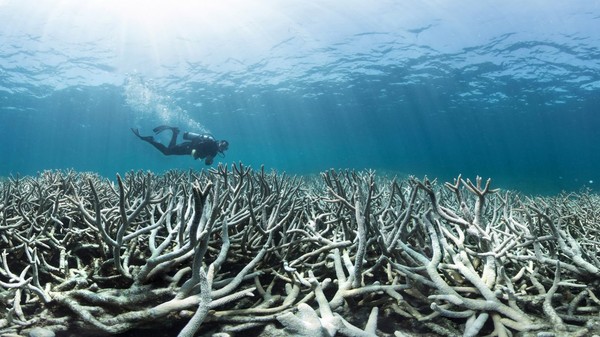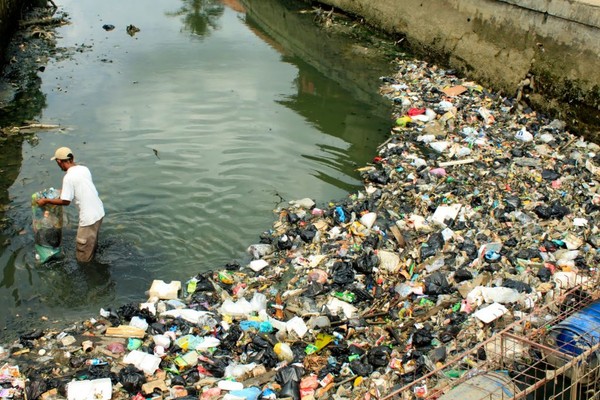
Youth Activists Lead Global Climate Movement
By Ada Carpenter Editor-in-Chief
In one of the “largest coordinated global protests in history”, more than 7.6 million people around the world took to the streets and raised their pickets at the end of September, demanding action on the climate crisis from world leaders and international stakeholders. Culminating with a global day of action on September 27, the Global Climate Strike took place across 185 countries in more than 6,000 events.
Shortly prior, all eyes were on the docks of New York as an emission-free sailing boat glided into harbor. On board was 16-year-old Greta Thunberg, the Swedish climate icon who has captured the passion and anger of a generation, and along with it the attention of major media outlets. Arriving in the US to speak at the United Nations Climate Action Summit, she subsequently led the climate strike in New York, and will remain in the Americas for the upcoming months to engage with public events and further demonstrations.
On September 23, 16 young people presented an official human rights complaint to the UN, naming Germany, France, Brazil, Argentina, and Turkey as violators of the UN Convention on the Rights of the Child for their failure to act in response to the climate crisis. The five major nations challenged by the youth activists are the worst polluters amongst the countries who have ratified the whole treaty. A dozen nationalities were represented by the children, including Ridhima Pandey from India, Ayakha Melithafa from South Africa, and Alexandria Villaseñor from the US. The complaint they brought forth in a joint press conference details the pitiful efforts made towards limiting global warming to 1.5 degrees Celsius, as well as the devastating impacts a warming planet will have on the livelihoods and traditions of their communities.
Greta Thunberg has seized her chance to make a difference, and rightly so, but the people who march beside her are equally important. Canadian indigenous activist Autumn Peltier has addressed major forums, including the UN, multiple times in the past year since becoming chief water commissioner for Anishinabek Nation aged only 14. Brianna Fruean, a 20-year-old from Samoa, has already been campaigning for climate justice for nearly a decade, and won the Commonwealth Youth Award for her environmental activism at 16. And Xiye Bastida grew up learning the Mexican Otomi teachings of unity with the environment, now translating this into self-described “climate justice activism” throughout her high school years. Countless more youth activists are finding their feet and voices, creating a movement that can surely not go unnoticed.
In this month’s feature, we focus on the climate crises that aren’t so widely mentioned in mass media, giving prominence to the people and problems outside the spotlight. For while a catalyst in the form of Greta Thunberg is critical, we must not forget that this self-inflicted damage on our home is, indeed, global.
Losing Color: Ghost Coral Reefs
By Juhoon Lee Senior Staff Reporter
The global catastrophes on land have been garnering much attention from all over the world. Meanwhile, the quiet ocean harbors festering ecosystems, and the mass that has been absorbing the effects of man-made pollution on land is collapsing at a rapid pace. One need not look further than the destruction of the Great Barrier Reef off the northeastern coast of Australia to encounter the wounds left by irresponsible human activities.
The Great Barrier Reef, as the name suggests, is — was — a renowned coral reef brimming with patches of vibrant corals. “Australia’s Great Natural Wonder” is the largest coral reef in the world, consisting of over 2,900 individual reefs and spanning 800 km.

The last few years have been deadly for the marine habitat, as shown in a century-long study published in 2019 in Nature Communications. Corals are extremely sensitive to changing conditions such as increasing water temperature, pH levels, and runoff. Coral bleaching occurs when a coral becomes stressed due to different environmental changes and expels symbiotic algae from its tissues until its vulnerable white skeleton is revealed; the phenomenon has been the biggest contributor to coral deaths. Between 2016 and 2017, high water temperature resulting from global warming and higher acidity levels from increased carbon dioxide emissions have killed off swatches of the reef. The shock of the tragedy gripped the research community as they watched coral reefs perish within a matter of weeks.
Such sudden changes are leading to possibly irreversible changes in the coral population. 2018 showed a harsh drop in coral birth rates. More importantly, there have been several devastating phase shifts over the years, leading to much softer corals and leaving only the most resistant types alive. Consequently, whereas cyclones had minor and reversible effects on coral diversity and cover back in the 1950s; but recently, they have wrecked weakened corals and invertebrates in different regions of the world.
The ecological pandemic blights all reefs worldwide. Over 10% of the world’s reefs are already dead, with a 50% fatality rate predicted for 2030. According to the US National Oceanic and Atmospheric Administration, a bleaching event in 2005 killed half of the Caribbean coral population, a toll greater than those of the previous 20 years combined. Unlike other occurrences of environmental damage, coral reef decimation is sudden, brief, and absolute.
Coral reefs are portents, protectors, and producers of biodiversity and habitable marine ecosystems. If humans continue to refuse action, the sea will be a ghost town, cluttered with pallid remnants of the colorful past.
Indonesia: Mother Nature's Spoiled Little Child
By Chrysan Angela Staff Reporter
One could never exaggerate the extraordinary abundance of Indonesia’s natural resources. Blessed with year-round sunlight, rainfall, and fertile soil, it is the world’s largest producer of palm oil, cloves, and cinnamon, as well as a major supplier of rice, cassava, coffee, tea, and a plethora of other agricultural tropical products. Indeed, Mother Nature might have been too kind to Indonesia, to the point that the nation forgot how fortunate it was.

Natural disasters are perhaps as abundant as natural resources in this country. According to the National Disaster Management Authority, 1,113 windstorms, 871 floods, 615 landslides, and 527 forest fires occurred in Indonesia in 2018. While windstorms are relatively unpreventable, the same cannot be said for other commonly occurring disasters — in which humans are the main culprit. Over the past 50 years, 74 million hectares of Indonesian rainforests have been deforested for mostly greedy purposes, primarily to open up land for agriculture using slash-and-burn techniques. This then acts as a catalyst to ignite widespread forest fires. In addition, Indonesia produces approximately 190,000 tons of waste every day, most of which is thrown into landfill or water bodies with little care for where or how it will end up. The result is evident: in 2018, 68 out of 89 Indonesian rivers were reported as heavily polluted. The clogging of the water arteries of the nation and the rapid razing of the forest inevitably trigger floods and landslides to a far greater extent than would occur naturally.
The world has repeatedly pointed out the urgency of solving Indonesia’s environmental issues to counter climate change, considering its undesirable rank as the world’s fifth biggest contributor of greenhouse gases. Knowing all the damaging effects of harmful practices, it seems ludicrous that the perpetrators still continue. But we cannot overlook the socio-economic background of Indonesians. Based on research by the Ministry of Health, only 20% of the population is aware of the importance of health and hygiene. In fact, only 59.8% of households have access to proper sanitation, and 8.3% of urban households live in slum areas. In terms of education, 55% of 15-year-old Indonesian children are still functionally illiterate. This lack of socio-economic welfare and education forms a vicious cycle that will be challenging to overcome. It is difficult to expect people to care about education if they can barely afford a decent meal and home; however, without proper education, it is near-impossible to escape this impoverished state. When family and friends fail to give an example, school becomes the only viable institution to impart environmental awareness to the young generation and break this chain of poverty.
Perhaps Mother Nature has pampered Indonesia too much. The ease of agriculture and the bountiful supply of natural resources might have lulled them into forgetting that this blessing is not limitless. To combat the environmental damage in Indonesia, its social issues should be addressed first.
Fires in Siberia
By Duman Kuandyk Staff Reporter
The Amazon rainforest is not the only forest on fire recently. Extensive forest fires broke out all across Siberia this summer, and have already reached unprecedented levels. Since the middle of July, thousands of activists have been demanding action to save the Siberian forests, but millions of hectares are still engulfed by flames.
The forest fires began in the Irkutsk region of Russia at the end of June and grew rapidly. In the second half of July, residents began to complain about smog, and by the end of the month, the smoke had reached Kazakhstan. NASA announced in early August that smoke from the Siberian forest fires had reached as far as North America.
Despite the scale of the disaster, regional governments did nothing to prevent forest fires from spreading, justifying the inaction by citing a “lack of economic viability’’, Regional commissions on emergencies referred to Order No. 426 in their decision not to extinguish fires in distant areas. Recently signed in 2015, the order divided Russian forests into “control zones” and “service zones”, and regional commissions for emergencies were permitted to let fires pass in control zones — as long as they do not threaten residential and economic areas.
As the situation deteriorated, the Siberian regions attempted to extinguish the fires on their own, all the while complaining about the lack of resources. Periodic forest fires are a natural process in Siberia, but there is no action from the government — after the adoption of the Forest Code in 2006, thousands of foresters who monitored the condition of the forest were fired.
On July 31, President Putin ordered the Ministry of Defense to extinguish the fires. Following this, federal officials quickly accused regional colleagues of incompetence. The Ministry of Emergency Situations stated that the situation in Siberia developed because local officials did not take sufficient measures to eliminate them: “Municipalities and regions failed to cope with the situation and it reached the federal level of response.”

Regional governments retaliated by saying that most of the fires start sporadically in hard-to-reach areas due to lightning strikes and other natural causes. Not everyone agrees with that statement. Vladimir Maximov, an environmental activist in Siberia, says that up to 99% of forest fires are caused by human activity — most of the fire outbreaks are located along forest roads. Most activists believe that the setting of fires to cover up illegal logging is the primary cause of the widespread fires. Tatyana Davydenko, former head of the Krasnoyarsk Audit Chamber, confirms that illegal logging is directly related to fires. “The place where the salvage logging was carried out and the place where the fires started [coincide],” said Davydenko.
At the end of July, the Federal Ministry of Natural Resources promised to revise the borders of the control zones. However, Russian environmental activists believe that simply changing the demarcation of control zones is not enough; local forest facilities also need significant increases in inventory and financing.
As of October 7, most of the Siberian forest fires have been extinguished. Regional governments believe that the rest will stop naturally due to the upcoming winter season. Environmentalists, however, warn that with the current scale of periodic forest fires and illegal logging, Russia risks losing the entirety of the Siberian forests in just ten years.
Rapid Glacier Meltdowns in Greenland
By Sean Tristan De Guzman Head of International Division
Climate change is propelling increases in temperature at the polar caps of the globe. In late July, the summer heatwave in Europe made its way to Greenland. It got hot enough to exceed the melting point of the ice sheets, resulting in the meltdown of a staggering 12.5 billion tons of ice in just 24 hours. The total volume of melted ice this summer could submerge the whole state of Florida to at least five inches. The last observed occurrence of similar extremity was seven years ago, when about 250 billion tons of the Greenland ice sheet melted, enough to elevate global sea levels by an eighth of a millimeter.

Greenland is home to glaciers that could raise global sea levels by as much as seven meters when fully melted. Fortunately, that event is improbable, at least for the next few centuries. But the rapidly accelerating rates of glacier meltdown deserve a fair amount of panic, especially because of their implications for low-lying areas. Rising sea levels may worsen the already severe difficulties in disaster prevention and agricultural maintenance in developing countries. In worst-case scenarios, islands could become completely submerged. Particularly in the Pacific region, ordinary high tides already cause heavy flooding on certain islands. Even the slightest increase in sea levels may further amplify these problems. Among other regions likely to be affected are eastern England, the Netherlands, and Bangladesh.
There is also a health risk from ice thaws that necessitates louder calls for immediate action. Steadily warming temperatures melt permafrost — largely frozen masses of soil that trap huge amounts of carbon-based matter, poisonous mercury, and ancient dormant microbes. Not only will the consequent release of large carbon concentrations in the atmosphere reinforce the effects of global warming, but we could also potentially face a deadly threat from reemerging ancient diseases. These will have become alien to our evolved immune systems and may be difficult to combat with present scientific knowledge.
The 2016 anthrax outbreak in Siberia suggests that such threats might already be tangible. After 75 years, the disease returned, infecting about 2,300 reindeer and 72 nomadic herders. Authorities claim that the thawing of permafrost may have awakened anthrax spores preserved in the depths of the ice.
As things stand, our inaction will surely bring about more costly implications than we can handle. The clock is ticking, and eventually, we may no longer be able to remedy our self-created fate.

